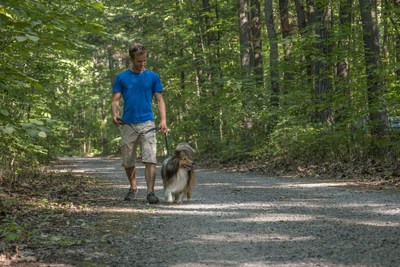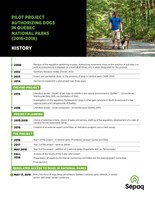QUÉBEC, Oct. 16, 2018 /CNW Telbec/ - In light of the results of the pilot project conducted since 2016, Sépaq will allow access to visitors accompanied by a dog in certain sectors and under certain conditions in most Québec national parks as of May 17, 2019.


"We have rigorously analyzed the data collected in five national parks and have noted that the rules established to preserve the natural environments and foster harmonious cohabitation have been respected and that the customer experience is not negatively affected by the presence of dogs," noted Sépaq Vice President, National Parks Operations, Catherine Grenier.
Starting next spring, in most Sépaq national parks, dogs will be allowed along certain camping loops and clearly defined trails. Other than in these sectors, dogs will not be allowed so as to preserve the visitor experience of those who do not wish to encounter dogs and to protect more sensitive environments.
Anticosti and Île-Bonaventure-et-du-Rocher-Percé national parks, because of their specific biological constraints and their special characteristics, will not allow dogs.
Between now and spring 2019, the five national parks that were part of the pilot project (Oka, Jacques-Cartier, Frontenac, Aiguebelle, Lac-Témiscouata) will continue to allow dogs under the conditions already in effect.
Wildlife reserves and tourist establishments already allow dogs. An increasing number of Québec families consider their dog as a full-fledged member of the household.
Responsible owners
The three-year pilot project revealed a high compliance rate with the rules imposed on owners to limit the impact of their dogs during very busy periods. Here are some examples:
- Dogs kept on a leash: 93% (summer) and 95% (fall)
- Leash of no more than 3 metres: 96% (summer) and 97% (fall)
- Presence of feces in campgrounds: less than 1%.
- Customer satisfaction rate: 92% (campgrounds) and 98% (day visitors)
The same rules will apply everywhere where dogs are allowed. Compliance will continue to be measured and enforced by various means of monitoring, including park warden patrols.
Sépaq collaborated with an external committee of experts, including scientific researchers and animal health representatives among others, throughout the duration of the pilot project.
Adjustments can still be made
Adjustments may be made to increase monitoring if rates of compliance with the rules begin to decrease. Dogs could again be banned for good or for a specific period of time on a trail, in a sector, or throughout an entire park if the rules are not respected.
The behaviour of dog owners has been at the heart of the pilot project. The exercise has shown that due to peer pressure they are more likely to follow the rules in the busiest areas. The concentration of the offering accessible to dogs in busy sectors can contribute positively to the compliance rate, notably during the cold season.
Protected sensitive environments
Authorized sectors have been grouped together in clearly defined areas to promote a clear understanding among visitors and facilitate rule enforcement. These areas have been selected based on limited potential impacts on natural environments, a capacity to enforce the rules, and the possibility for multi-purpose use.
In the months ahead, clear signposting in national parks will be unveiled, employees will be trained, and the population will be informed about these developments.
Sépaq is opting for an integrated and harmonious approach that promotes respect for natural environments and preserves the customer experience while allowing regulated access for dogs.
– Authorized sectors as of May 2019 are indicated here: https://www.sepaq.com/animaux/index.dot?language_id=1
– See also the appended pilot project fact sheets.
SOURCE Société des établissements de plein air du Québec
Simon Boivin, Media Relations Coordinator, Sépaq, 418-380-5875, ext. 2326, [email protected]
Share this article